Chicken Of The Woods – A Visual & Culinary Delight
- Laeitiporus Sulphureus
SHAPE : SEMI CIRCULAR LAYERED BRACKETS 8-45CM ACROSS
HABITAT : OAK MAINLY, SOMETIMES YEW
FREQUENCY : COMMON
BEST TIME TO FORAGE :AUTUMN (AUGUST / SEPT)
WARNING : MUST BE COOKED | AVOID PICKING FROM YEW
Well what a year 2022 was! The summer seemed to roll on forever and with hardly any rain it made for what was to become the greatest wild fungi and mushroom foraging year I have ever experienced.
For those of you that were fortunate enough to come with me on a workshop then you will have seen the delight first hand as I beamed my way from pastures through bridelways and onto and into the forests and woodlands of Sussex. Armed with the knowledge and the desire to further my culinary range of wild specimens, I set off with my trusty trug and foragers walking stick on a daily basis.
I usually start to get excited on my annual summer holiday at the beginning of August. Often taking the campervan up to Wales and enjoying some rather long and enduring walks with my partner Tan and my son, its this time of year that one of my favourite bracket fungi is starting to emerge. With its almost sulphuric colouring and distinctive wavy comb of fleshy meat it can only be Chicken of the Woods! Scientifically known as Laetiporus Sulphureus.
It is one of the most beautiful looking of the bracket fungi and I can spend a good half hour sometimes just photographing and admiring such a wonder. Having scoured the campsite on my inaugural walk, there was not much joy, and maybe it had been so hot and dry that it could be another poor year for me. That was the pessimistic approach but after 35 years of foraging for wild mushrooms I know things can turn on a sixpence.
The following day walking alongside the River Towy I glanced down the steep riverside embankment, my eye catching a glimpse of bright orange. At first I thought it was a traffic cone as the colour was so vibrant and with limited view, due to the thickened hedgerow, it was only a glimpse. Again, now filled with optimism I walked a few yards to an opening to find a huge fallen Oak tree on a more or less 45 degree angle, down a scraggy slope. Wow! There THEY are!!! Gobsmacked by the sheer quantity around a dozen perfect examples of my treasure. Perfectly formed with firm looking texture, I was at least to say … excited.
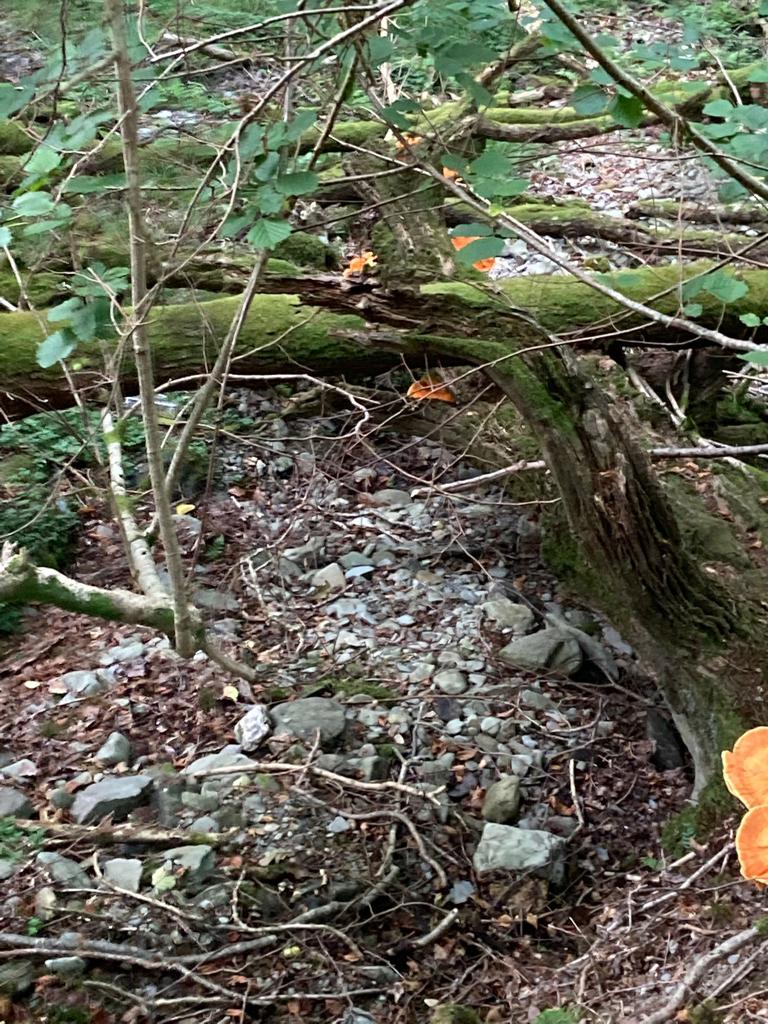
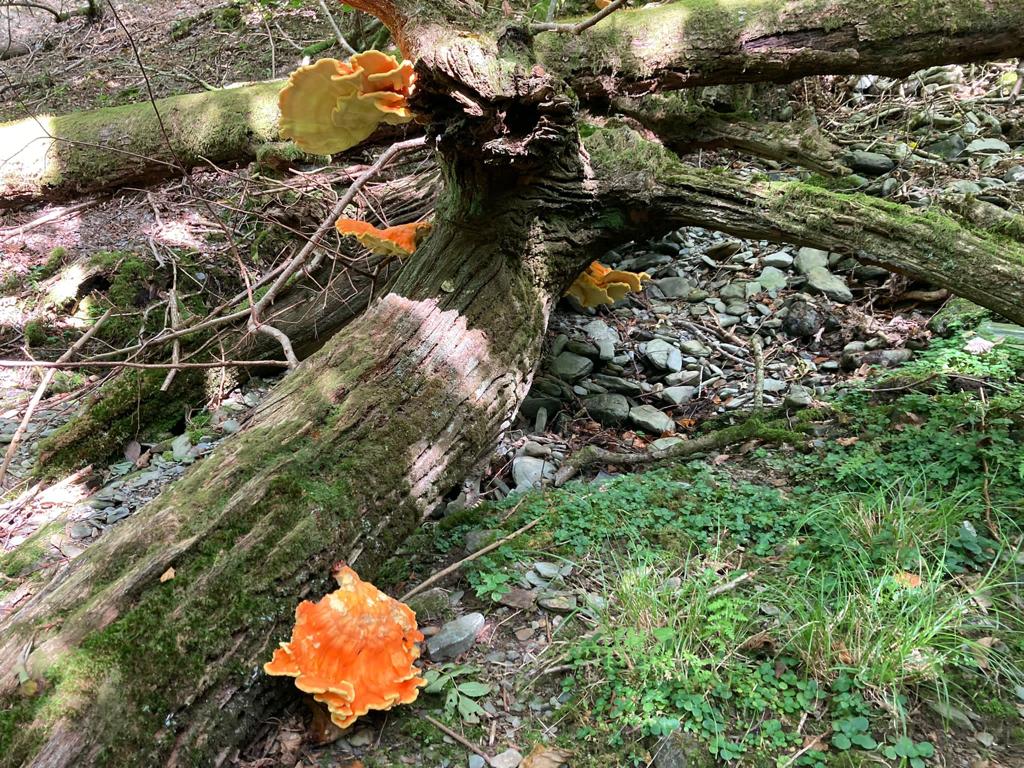
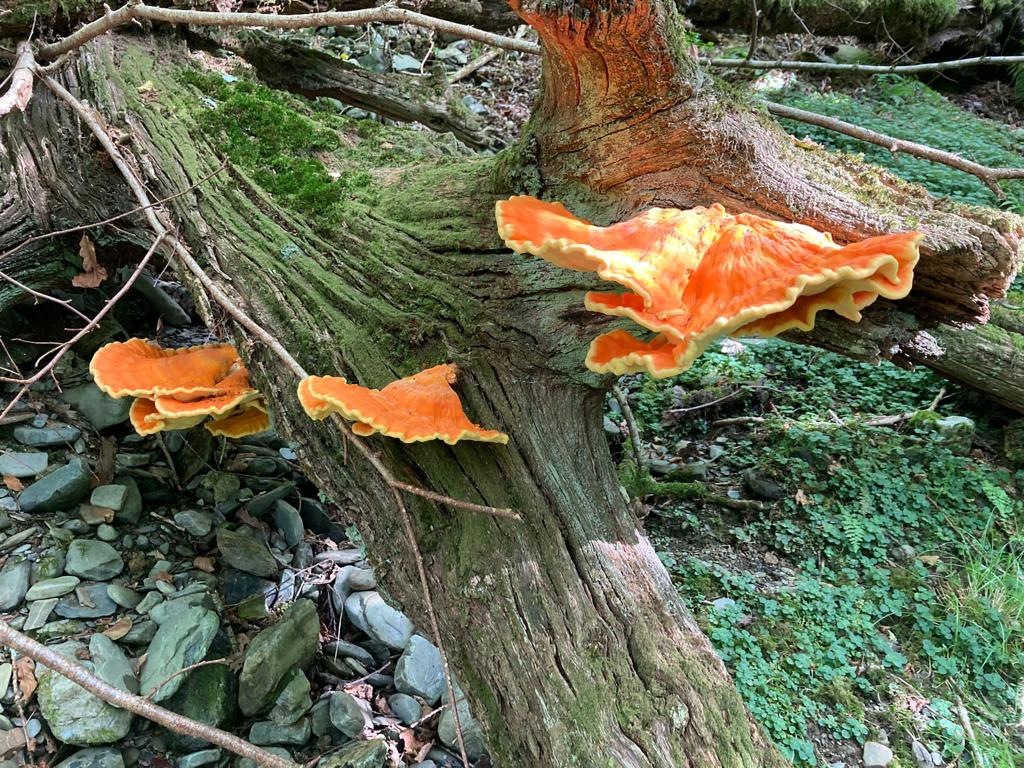
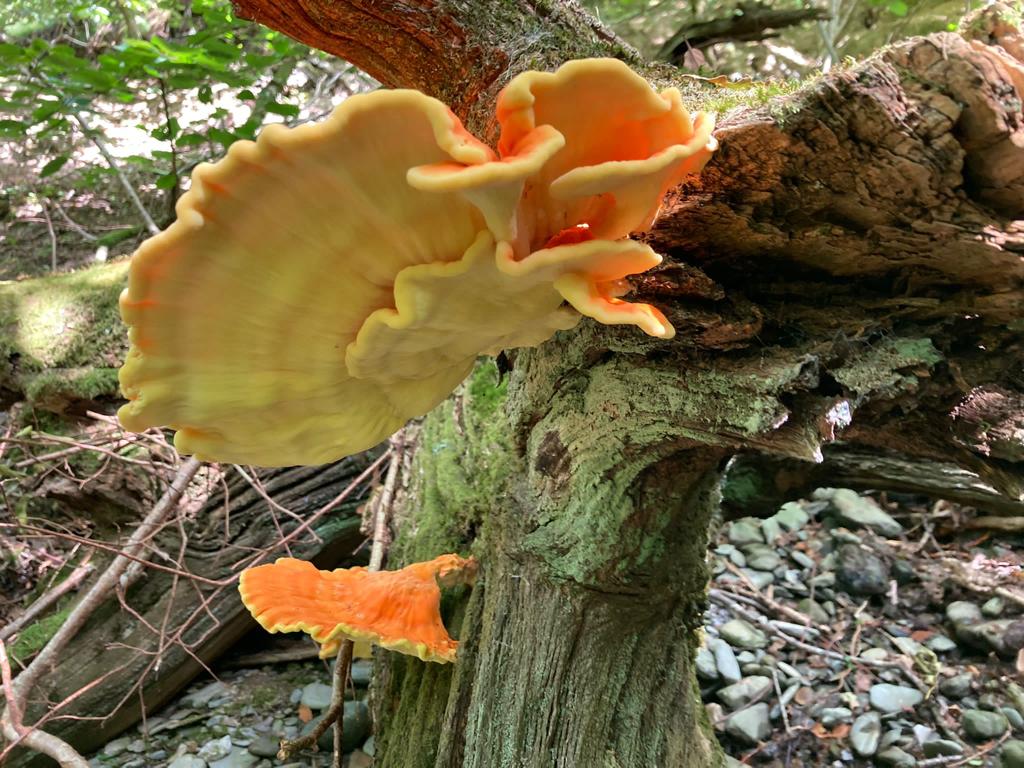
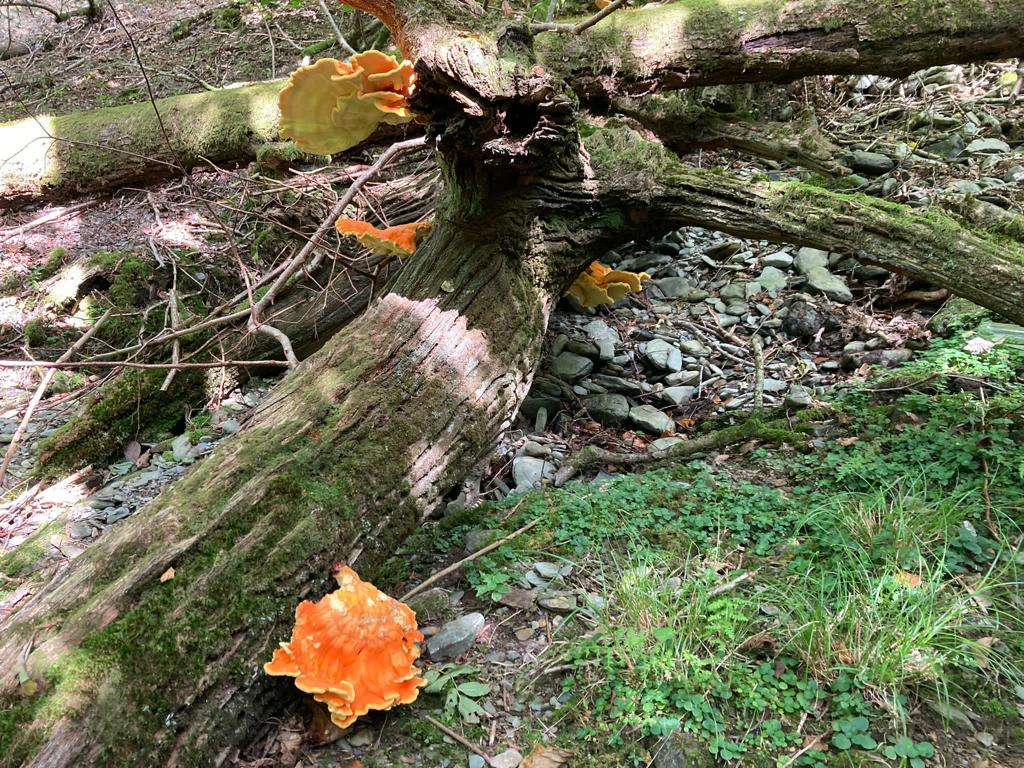
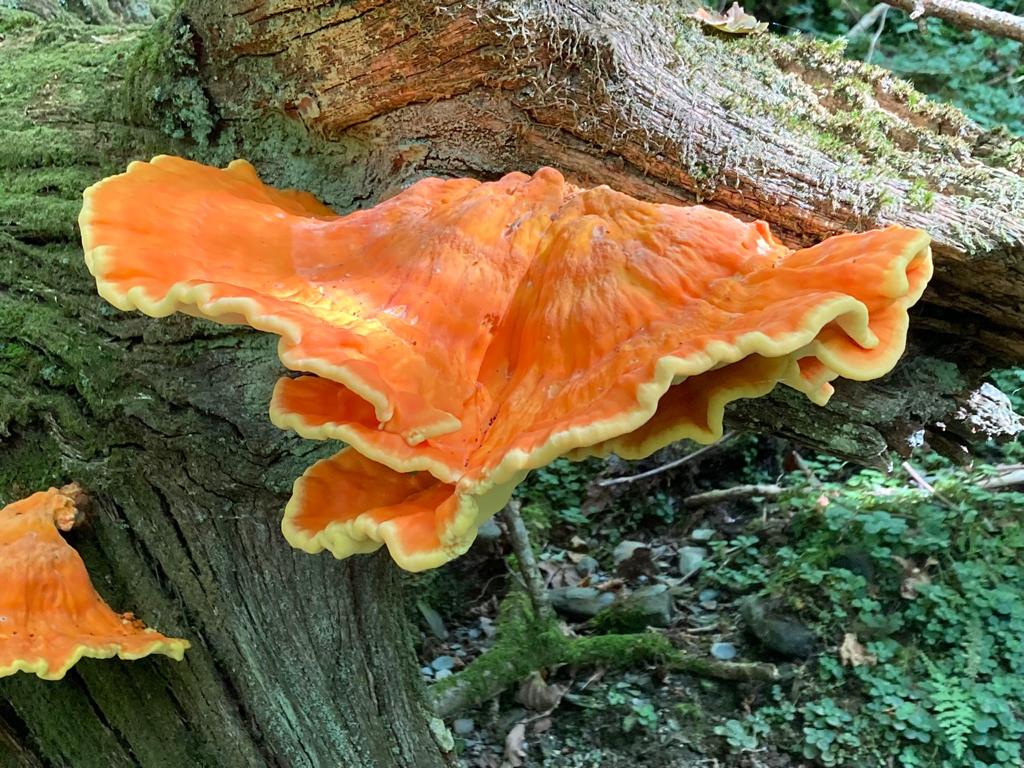
A plan was needed in order to recover some of the bounty, so with backpack emptied and all sense of danger eliminated by the sheer desire to acquire such tasty free food, I started my descent. Whoever said foraging was a stroll in the park was wrong!
Once down and after a few slides on the backside (almost like sledging) I arrived at the glorious golden and seville orange coloured parasite. A parasite because Chicken of the woods is a killer of trees and was probably the reason this Oak met its fate. Once the spores infect a tree it can weaken the immune system and over a period of approximately 10 years after which the tree will start too die back. On the plus side you now have roughly ten plus years potentially, to keep cultivating this free food, as this mushroom, if foraged carefully and cut properly, should reappear year after year. It will reproduce over many years, depending on conditions so it’s vital for the seasoned forager to always keep a note of where you find this particular fungi. Either mentally (which is where most of my locations are as I don’t personally write them down in case someone reads my secrets). I certainly wont tell people of my secret Winter Chanterelle patch or the several Horn of Plenty locations, I have discovered over the many years of foraging.
Taking my foraging knife I carefully selected the very best example that would fit into the backpack to continue on our walk,. The Chicken of the Woods can actually be surprisingly heavy so only take what you need for a few days then leave the rest for the next ‘due to be excited forager’ or just left for nature to take its course. They are there for a reason after all, even if that does mean killing an Oak, as they then have the ability to begin breaking it down with the help of other fungi to a finer substance, providing food for the riverside embankment and all that live within. A truly beautiful example of a symbiotic relationship between nature, you and the plate. A culinary and visual delight!
The Chicken of the Woods doesn’t only look like a chickens comb stuck in a tree it actually tastes like Chicken, feels like chicken and even the texture when you cut through would be hard to tell the difference between that and the feathered variety, and that makes it a truly versatile mushroom in the culinary sense.
Once back to the campsite and with the bounty now sticking out proudly from the top of my rucksack, which certainly caused a few enquires from intrigued neighbours, it was on with with the frying pan and out with the chopping board.
You MUST cook Chicken of the Woods and not eat it uncooked as it can give a very different reaction if eaten raw… and one that some might find unpleasant.
Slice some of the Fungi into strips and add to the frying pan for a gentle heat for 5 mins and remove onto some kitchen paper to absorb the oil. Then you can dip in egg yolk and cover with breadcrumbs. Finally fry them until golden to create a Chicken of the Woods schnitzel Delicious!! You can also add to curries and I really love it as an addition to a full morning fry up! It keeps well, and can be preserved in olive oil in Kilner jars for winter months. See our workshops on Pickling and Preserving for more information. If you are interested in learning how to identify Chicken of the Woods then please book a late August Wild mushroom foraging workshop as this will be in tune with the species covered here.
Please remember to forage responsibly and carefully! Never eat anything you are not 100% certain.
One response
What a brilliant blog, it’s informative and very interesting , hopefully it will get novice foragers excited in getting started .